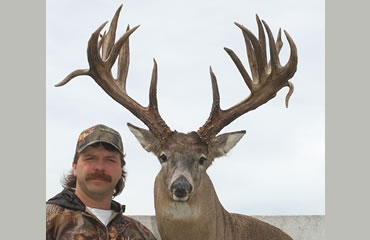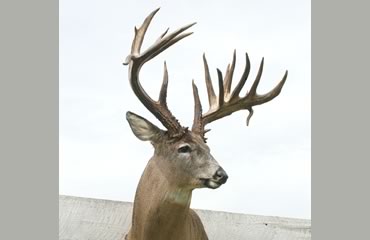By 7 a.m. on Nov. 14, 2005, I was heading to our hunting ranch near Spiritwood, Saskatchewan. On the way, I decided to check on a field where I had seen some nice bucks. Sure enough, there were fresh tracks from the early-morning snow. I spotted a doe on a hill a half-mile away, so I went to check her out. Then, there he was! With my naked eye, I could tell the buck I was looking at was a shooter.
I told myself, “He’s going down!” I sat in the truck and watched for a few minutes before the buck followed the doe over the hill. I was hoping they would be on the other side; but the wind was in their favor, and as soon as I reached the hill, the pair winded me and took off. They ran a good 700 yards into the brush.
I pinpointed where they disappeared and from that point started out on foot through the brush. I tracked them for a quarter-mile and finally spotted them running. With no chance of a shot, I ran to where I thought the deer would come out in the open. I could hear the bush rustling and realized the buck was behind me! I still had no shot.
Next the duo raced toward a farm road. Being familiar with the area, I walked back to the truck and kept thinking about the buck. Every time I pictured him, he got bigger and bigger. I drove around to the road and started to walk toward where I thought the pair would be.
I was getting tired and wondered if I would ever see that buck again. But it’s not in me to give up. I continued on until I found their tracks. This time the wind was in my favor.
 I tracked the deer carefully until I caught sight of the doe; I knew the buck had to be close. Raising my .30-06 Remington pump, I waited until the doe spooked. Then I spotted the buck about 100 yards through the brush. I fired and missed, then reloaded and picked another opening. When he entered the scope, I squeezed the trigger. The buck took three somersaults, then got up and ran.
I tracked the deer carefully until I caught sight of the doe; I knew the buck had to be close. Raising my .30-06 Remington pump, I waited until the doe spooked. Then I spotted the buck about 100 yards through the brush. I fired and missed, then reloaded and picked another opening. When he entered the scope, I squeezed the trigger. The buck took three somersaults, then got up and ran.
I couldn’t believe it.
Shaking, I went to where the buck had been when I shot. I found blood where it fell, so at least I had blood for tracking.
I followed the trail another quarter mile before I saw the doe again. She spooked and, sure enough, there was the buck, running behind her. I stayed on the trail, hoping to get another chance before dark, which was approaching quickly.
I walked another 600 yards down a valley. When I got to the bottom, I spotted the doe again — and the buck was walking toward her. But wait a second: It was not “the buck.”
I heard a snap in the brush to the right of the doe and there he was, standing broadside in some thick stuff. It was obvious that the doe was in full estrus, since he followed her all day, even after being wounded.
With the crosshairs on the shoulder of the buck, I squeezed the trigger and — I’m not ashamed to say — missed again. Between the excitement of the buck and the exertion of tracking, it was difficult to hold the rifle perfectly steady.
 The buck jumped and trotted up the hill toward the doe. She was looking at me, and the buck was looking at her with only one thing on his mind. Not knowing I was there, he stopped in an opening facing straight away. I knew this was my last chance; there was only 15 minutes of shooting time left. I squeezed the trigger one more time. The buck fell over backward, and I almost did the same in relief.
The buck jumped and trotted up the hill toward the doe. She was looking at me, and the buck was looking at her with only one thing on his mind. Not knowing I was there, he stopped in an opening facing straight away. I knew this was my last chance; there was only 15 minutes of shooting time left. I squeezed the trigger one more time. The buck fell over backward, and I almost did the same in relief.
As I ran to him, he got bigger and bigger. “What have I done?” I asked myself. All sorts of things ran through my mind. With a big smile on my face, I looked up at the sky and thanked my cousin and longtime hunting friend, Steve Boyas, who’d passed away from cancer. I feel in my heart that he was with me that day and gave me the strength to keep going.
– The Tiringer buck measures 222 7/8 BTR in the Irregular antler category and has a composite score of 246 5/8.
This article was published in the December 2006 edition of Buckmasters Whitetail Magazine. Join today to have Buckmasters delivered to your home.